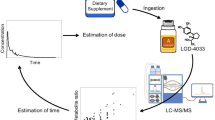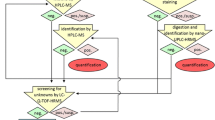Abstract
Since January 2009, the list of prohibited substances and methods of doping as established by the World Anti-Doping Agency includes new therapeutics such as the peroxisome-proliferator-activated receptor (PPAR)-delta agonist GW1516, which is categorized as a gene doping substance. GW1516 has completed phase II and IV clinical trials regarding dyslipidemia and the regulation of the lipoprotein transport in metabolic syndrome conditions; however, its potential to also improve athletic performance due to the upregulation of genes associated with oxidative metabolism and a modified substrate preference that shifted from carbohydrate to lipid consumption has led to a ban of this compound in elite sport. In a recent report, two presumably mono-oxygenated and bisoxygenated urinary metabolites of GW1516 were presented, which could serve as target analytes for doping control purposes after full characterization. Hence, in the present study, phase I metabolism was simulated by in vitro assays employing human liver microsomal fractions yielding the same oxygenation products, followed by chemical synthesis of the assumed structures of the two abundant metabolic reaction products. These allowed the identification and characterization of mono-oxygenated and bisoxygenated metabolites (sulfoxide and sulfone, respectively) as supported by high-resolution/high-accuracy mass spectrometry with higher-energy collision-induced dissociation, tandem mass spectrometry, and nuclear magnetic resonance spectroscopy. Since urine samples have been the preferred matrix for doping control purposes, a method to detect the new target GW1516 in sports drug testing samples was developed in accordance to conventional screening procedures based on enzymatic hydrolysis and liquid–liquid extraction followed by liquid chromatography, electrospray ionization, and tandem mass spectrometry. Validation was performed for specificity, limit of detection (0.1 ng/ml), recovery (72%), intraday and interday precisions (7.7–15.1%), and ion suppression/enhancement effects (<10%).

The detection of GW1516, a drug candidate potentially enhancing athletic performance, and the identification of major urinary metabolites for doping control purposes is described using liquid chromatography-mass spectrometry.






Similar content being viewed by others
References
Thevis M, Thomas A, Kohler M, Beuck S, Schänzer W (2009) Emerging drugs: mechanism of action, mass spectrometry and doping control analysis. J Mass Spectrom 44:442–460
Narkar VA, Downes M, Yu RT, Embler E, Wang YX, Banayo E, Mihaylova MM, Nelson MC, Zou Y, Juguilon H, Kang H, Shaw RJ, Evans RM (2008) AMPK and PPARdelta agonists are exercise mimetics. Cell 134:405–415
Wang YX, Zhang CL, Yu RT, Cho HK, Nelson MC, Bayuga-Ocampo CR, Ham J, Kang H, Evans RM (2004) Regulation of muscle fiber type and running endurance by PPARdelta. PLoS Biol 2:e294
World Anti-Doping Agency (2009) The 2009 prohibited list http://www.wada-ama.org/rtecontent/document/2009_Prohibited_List_ENG_Final_20_Sept_08.pdf. Accessed 02 January 2009
US National Institutes of Health (2009) Regulation of lipoprotein transport in metabolic syndrome. www.clinicaltrials.gov. Accessed 21 September 2009
Wang YX, Lee CH, Tiep S, Yu RT, Ham J, Kang H, Evans RM (2003) Peroxisome-proliferator-activated receptor delta activates fat metabolism to prevent obesity. Cell 113:159–170
Krämer DK, Al-Khalili L, Guigas B, Leng Y, Garcia-Roves PM, Krook A (2007) Role of AMP kinase and PPARdelta in the regulation of lipid and glucose metabolism in human skeletal muscle. J Biol Chem 282:19313–19320
Luquet S, Lopez-Soriano J, Holst D, Gaudel C, Jehl-Pietri C, Fredenrich A, Grimaldi PA (2004) Roles of peroxisome proliferator-activated receptor delta (PPARdelta) in the control of fatty acid catabolism. A new target for the treatment of metabolic syndrome. Biochimie 86:833–837
Brunmair B, Staniek K, Dorig J, Szocs Z, Stadlbauer K, Marian V, Gras F, Anderwald C, Nohl H, Waldhausl W, Furnsinn C (2006) Activation of PPAR-delta in isolated rat skeletal muscle switches fuel preference from glucose to fatty acids. Diabetologia 49:2713–2722
Thevis M, Beuck S, Thomas A, Kortner B, Kohler M, Rodchenkov G, Schänzer W (2009) Doping control analysis of emerging drugs in human plasma - identification of GW501516, S-107, JTV-519, and S-40503. Rapid Commun Mass Spectrom 23:1139–1146
Thevis M, Thomas A, Kohler M, Beuck S, Möller I, Schäfer M, Rodchenkov G, Yin S, Loo JA, Geyer H, Schänzer W (2009) Presented at the 18th International Mass Spectrometry Conference, Bremen
Kuuranne T, Leinonen A, Schänzer W, Kamber M, Kostiainen R, Thevis M (2008) Aryl-propionamide-derived selective androgen receptor modulators: LC–MS/MS characterization of the in vitro synthesized metabolites for doping control purposes. Drug Metab Dispos 36:571–581
Wang Z, Hop CE, Kim MS, Huskey SE, Baillie TA, Guan Z (2003) The unanticipated loss of SO2 from sulfonamides in collision-induced dissociation. Rapid Commun Mass Spectrom 17:81–86
Weigend F, Haser M, Patzelt H, Ahlrichs R (1998) RI-MP2: optimized auxiliary basis sets and demonstration of efficiency. Chem Phys Lett 294:143–152
Ahlrichs R, Bar M, Haser M, Horn H, Kolmel C (1989) Electronic-structure calculations on workstation computers—the program system turbomole. Chem Phys Lett 162:165–169
Häser M, Ahlrichs R (1989) Improvements on the direct Scf method. J Comp Chem 10:104–111
Thevis M, Geyer H, Mareck U, Schänzer W (2005) Screening for unknown synthetic steroids in human urine by liquid chromatography–tandem mass spectrometry. J Mass Spectrom 40:955–962
International Conference on Harmonisation (2004) Validation of analytical procedures: methodology. http://www.ich.org/LOB/media/MEDIA417.pdf. Accessed 28 January 2007
Kromidas A (1999) Validierung in der Analytik. Wiley, Weinheim
Dams R, Huestis MA, Lambert WE, Murphy CM (2003) Matrix effect in bio-analysis of illicit drugs with LC-MS/MS: influence of ionization type, sample preparation, and biofluid. J Am Soc Mass Spectrom 14:1290–1294
Matuszewski BK, Constanzer ML, Chavez-Eng CM (2003) Strategies for the assessment of matrix effect in quantitative bioanalytical methods based on HPLC–MS/MS. Anal Chem 75:3019–3030
Sun M, Dai W, Liu DQ (2008) Fragmentation of aromatic sulfonamides in electrospray ionization mass spectrometry: elimination of SO(2) via rearrangement. J Mass Spectrom 43:383–393
Thevis M, Schmickler H, Schänzer W (2002) Mass spectrometric behavior of thiazide-based diuretics after electrospray ionization and collision-induced dissociation. Anal Chem 74:3802–3808
Acknowledgments
The study was carried out with support of the German Federal Ministry of the Interior, the Ministry of Sports, Tourism, and Youth Policy of the Russian Federation, and the Manfred-Donike Institute for Doping Analysis.
Author information
Authors and Affiliations
Corresponding author
Rights and permissions
About this article
Cite this article
Thevis, M., Möller, I., Thomas, A. et al. Characterization of two major urinary metabolites of the PPARδ-agonist GW1516 and implementation of the drug in routine doping controls. Anal Bioanal Chem 396, 2479–2491 (2010). https://doi.org/10.1007/s00216-009-3283-x
Received:
Revised:
Accepted:
Published:
Issue Date:
DOI: https://doi.org/10.1007/s00216-009-3283-x




